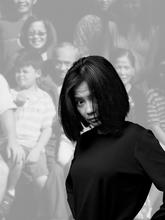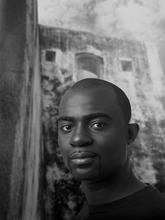This Q&A is featured in the Guthrie's program for the production of Refugia.
Interview by Justin Pelegano, Guthrie Theater
Photographer, SJMC alum and instructor Peter Beck’s documentary portrait series “Promise,” which is currently on exhibit in theGuthrie Theater's Level One lobby, honors the optimism and strength of 11 immigrants who call Minnesota home. Beck recently spoke with Guthrie Publications Manager Justin Quinn Pelegano about the inspiration behind his images. Beck's work is on display during the production of Refugia, a play that explores the displacement of people (closes June 11).
“Promise” strikes me as a global project on one hand, and yet also a uniquely intimate and local project. What sparked you to examine a vast topic through a Minnesota lens?
My interest in immigrant stories is connected to my late maternal grandparents, who helped raise me. They were Italian immigrants who passed through Ellis Island on their way to Minnesota in the early 1900s. “Promise” began as a response to the wave of anti-immigrant sentiment in the U.S. that took shape following the 9/11 attacks. By way of individual stories and portraits, my intent has been to offer evidence from the vast mainstream of immigrants who have helped to form and enrich America. I discovered quickly that Minnesota’s immigrant community was diverse and easily accessible to me. In essence, “Promise” is about a common humanity, the fragile or sinewy “ties that bind.”
I understand you attended journalism school. How did that course of study inform your work here?
I graduated from the University of Minnesota in 1970 with a B.A. in anthropology and photojournalism. In 2011, I returned and earned an M.A. from the university’s School of Journalism and Mass Communication with a special interest in immigrant identity. My graduate work illuminated patterns of global migration fueled often by political oppression, economic displacement and suppression of human rights. In my interviews, immigrants repeatedly identify democratic governance, economic opportunity and assurances of human rights as key factors motivating their migration to the U.S. However, it’s important to emphasize that in my experience most immigrants retain an abiding connection to their birth nation.
Something that stood out to me in your portraits is the background image layering or, in some cases, the subjects themselves are holding small photos in the foreground.
My immigrant portraits are hybrid and collaborative. I’ve asked each person to give me something tangible that connects them to their birth nation or to America. Immigrants have provided photographs, letters, memorabilia, documents and so on. Those items are in a sense artifacts from their lives and connected to their stories. I’ve then photographed one or more of these artifacts, which I’ve then composited or layered into the final portrait. I very much have worked to subordinate clothing to simple black or white garments. I want each immigrant to be encountered as an individual. I believe it’s on that sort of level playing field where viewers might be reminded of their own extended family histories.
How did you – or did you at all – direct your subjects as you were photographing them in order to achieve a specific look?
When I shoot portraits, I always talk to people about what I’m doing. The portraits I shot of each immigrant took place after interviews lasting up to two hours.
Those conversations were wide-ranging, unscripted and often began with: “What brought you to America?” Many immigrants asked me why I was interested in them and their stories. I tried to be open and frank, putting my cards on the table. I told them about my Italian immigrant grandparents’ roles in helping to raise me when my parents divorced. As for “a look,” I’m not sure exactly how to characterize it. I suppose I’ve tried to show real people, equipped with a measure of courage, confidence and perseverance.
What did you learn from “Promise” and the immigrants you collaborated with?
“Promise” has been a labor of love for me. Listening to many immigrants describe how and why they came to America has been rewarding and reassuring for me. Each has reminded me that a diverse group of individuals, Americans all, continue to expand and rejuvenate our shared homeland. What have I learned from this project? Two takeaways: My immigrant grandparents made the right decision in sailing for America. And our country’s greatest asset is a richly diverse citizenry.
To see more of Beck's work, visit the Promise website and watch for it in the upcoming issue of the Murphy Reporter.

